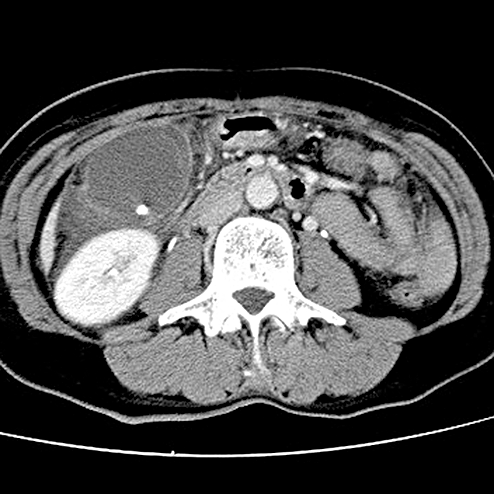Hepatobiliary and pancreatic: Torsion of the gallbladder
A 54-year-old woman was admitted to hospital with a 24 hour history of upper abdominal pain. Previous episodes had occurred that had been attributed to biliary colic. On examination, she had marked upper abdominal tenderness and a positive Murphy's sign. Various blood tests including a white cell count, liver enzymes and amylase were within the reference range. An upper abdominal ultrasound study showed a calculus in a distended gallbladder. The gallbladder wall was thickened to 6 mm when compared to a normal gallbladder wall of 3 mm or less. An abdominal computed tomography scan confirmed the presence of a calculus and, in addition, showed a somewhat enlarged gallbladder with pericholecystic fluid (Fig. 1). Laparotomy was performed and revealed torsion of the gallbladder associated with gangrene (Fig. 2). The gallbladder did not have a membranous attachment to the liver and there was an anticlockwise torsion involving the cystic duct and the neck of the gallbladder. The torsion was readily corrected and cholecystectomy was performed.


The first report of torsion of the gallbladder has been attributed to Dr A Wendel in an article in the Annals of Surgery in 1898. The disorder appears to be uncommon although at least 400 cases have been reported in the medical literature. The disorder is more common in women than in men (ratio 3:1) and patients have a mean age of approximately 70 years. There are coexisting gallbladder stones in 20% of patients. Factors that predispose to torsion include a free-lying gallbladder without a membranous attachment to the liver or a gallbladder that is completely enveloped by peritoneum with a long mesenteric attachment to the liver. The former is more common and occurs in approximately 4% of the normal population. Under most circumstances, the gallbladder does not have sufficient mobility to twist as it is firmly attached to its fossa on the under-surface of the liver by an extension of the peritoneum. A preoperative diagnosis of torsion of the gallbladder is rare as the clinical features can mimic acute cholecystitis. The surgical outcome is usually satisfactory although mortality rates of >10% have been reported, particularly when surgery is delayed.
Contributed by




